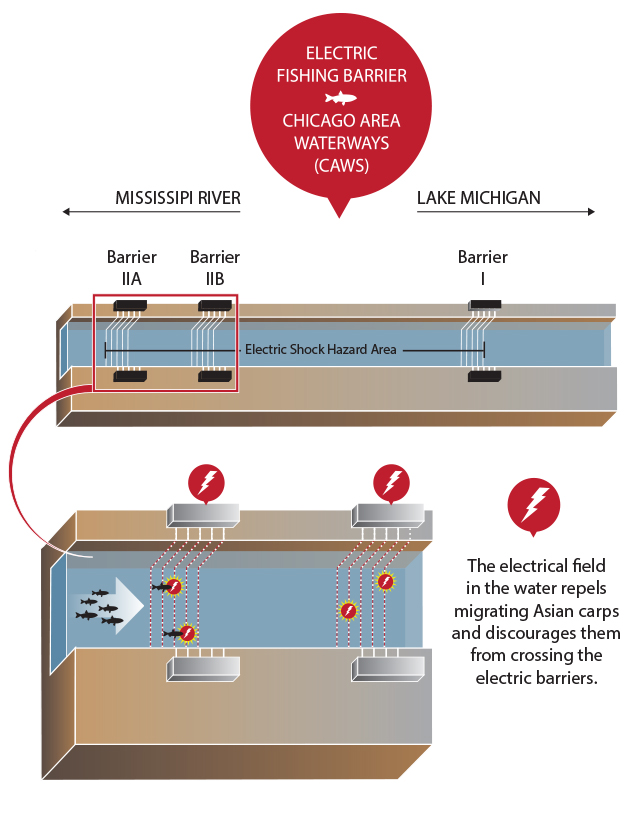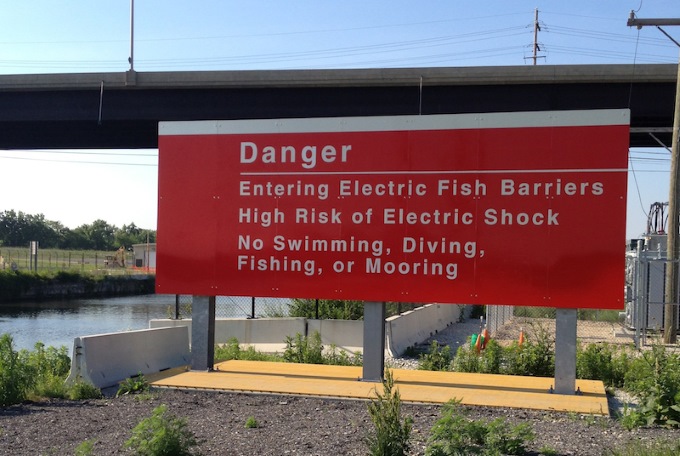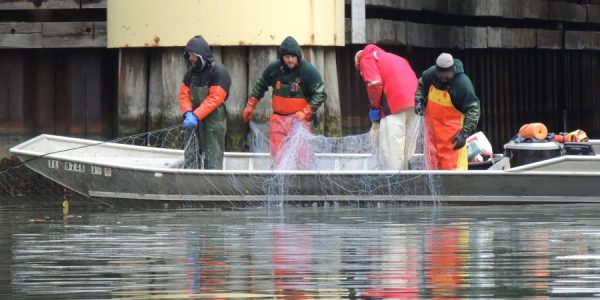Electric Dispersal Barriers in the CAWS
The Chicago Area Waterways (CAWS) is the largest known continuous connection between the Great Lakes and Mississippi River basins and, as such, poses the greatest risk for transfer of Aquatic Invasive Species (AIS). Electric dispersal barriers are located near Romeoville, Illinois, in the Chicago Sanitary and Ship Canal (CSSC) within the CAWS. These barriers are designed to prevent fish migration between the Mississippi River and Great Lakes basins through the CSSC. The barriers are comprised of steel electrodes secured to the bottom of the canal and are controlled from an adjacent building. Equipment in the control building generates a direct current (DC) pulse through the electrodes, creating an electrical field in the water that discourages fishes from crossing. This design does not prevent waterway vessel traffic.

The purpose of the U.S. Monitoring and Response Plan (MRP) is to identify the best strategy for conducting monitoring and response actions that will accomplish the goal of preventing Asian carps from establishing self-sustaining populations in the CAWS and Lake Michigan. The five strategic objectives to accomplish the overall goal are:
- Determination of the distribution and abundance of any Asian carp in the CAWS, and use this information to inform response removal actions.
- Knowledge of the distribution of Asian carps in the CAWS will inform decision makers on where and what actions are most appropriate to keep Asian carps from moving into Lake Michigan.
- Removal of any Asian carp found in the CAWS to the maximum extent possible.
- The Monitoring and Response Workgroup is taking a cautious approach by attempting to remove all known Asian carps upstream of the electric dispersal barrier. Removal may occur incidentally when Asian carps are captured during routine monitoring or during seasonal intensive monitoring actions targeting specific areas of the CAWS.
- Identification, assessment, and reaction to any vulnerability in the current system of electric dispersal barrier to prevent Asian carps from moving into the CAWS.
- Many measures have been undertaken or are being considered to prevent Asian carps from entering the CAWS and ultimately Lake Michigan. Some of these measures include: improving the electric dispersal barrier in the Chicago Sanitary and Ship Canal by constructing new barriers and operating barriers at appropriate operating parameters to better repel small and large fishes.
- Determination of the leading edge of major Asian carp populations in the Illinois River and the reproductive success of those populations.
- It is critical to gather information on carp densities in the area downstream of the electric dispersal barrier in order to effectively assess the risk of Asian carps passing the electric dispersal barrier, formulate response actions to reduce fish passage risks, and implement downstream population control measures.
- Improvement of our understanding of factors behind the likelihood that Asian carps could become established in the Great Lakes.
- Understanding the combination of environmental and biological variables that could lead to the introduction of Asian carp populations in the Great Lakes is important to the overall goal and may inform decisions regarding appropriate responses to Asian carps detected or captured in the CAWS.
Twenty projects are proposed to achieve the overarching goal and objectives of the 2014-2016 MRP. Project plans are included to showcase the full range of work that will be on-going or initiated during the coming year. These projects can be categorized geographically as occurring either upstream or downstream of the electric dispersal barrier and are grouped into five categories:
- Monitoring Projects
- Removal Projects and Evaluations
- Barrier Effectiveness Evaluations
- Gear Effectivness Evaluations and Development Projects
- Alternative Pathways Surveillance

A variety of sampling and removal tools are available to accomplish the plan objectives outlined above. They include traditional sampling gears (electrofishing, trammel nets, experimental gill nets, fyke or trap nets, tow nets, and seines), chemical pesticides (rotenone), high-tech sonic detection and imaging devices (sonic telemetry and hydroacoustics, DIDSON, and side-scan SONAR), and newly developed or developing techniques (eDNA, water guns, chemical barriers, and feeding attractants).
Larval Push Nets
Over the past four years, 0.5 meter diameter larval push nets have been used to sample for Asian carp eggs and larvae at stations located throughout the Illinois Waterway. Between 2010 and 2013, Asian carp eggs and larvae were only collected from the lower Illinois River. Monitoring for fish eggs and larvae will continue at stations throughout the waterway during 2014 and began when water temperatures were suitable for Asian carp spawning.

Contract Commercial Fishermen
The Illinois Department of Natural Resources has contracted commercial fishers to assist with monitoring and removal actions throughout the waterway upstream and downstream of the electric dispersal barrier. Commercial fishers are able to provide extensive knowledge of Asian carp habitats in large Illinois rivers, hands-on experience at capturing Asian carps, and have appropriate sized boats and specialized equipment necessary for effective netting operations.
Rotenone
Rotenone is a non-selective pesticide used to eliminate fish populations. The chemical is a valuable Asian carp eradication tool and it may be the best available sampling technique for determining fish population abundance, especially in the deep waters that comprise much of the CAWS. When applied in confined areas with appropriate water temperatures, most treated fishes float to the water surface within 3-4 days where they can be gathered, identified, and counted. Although rotenone treatments are valuable, recent experiences in the CAWS have shown rotenone actions to require extensive planning, labour, and financial expenditures. These applications are limited to targeted treatment areas within the CAWS, as treating the entire waterway is considered impractical due to costs, logistics, and availability of chemical.
Dual Frequency Identification Sonar (DIDSON) and Telemetry Studies
The Carterville Fish and Wildlife Conservation Offices (FWCO) of the United States Fish and Wildlife Services (USFWS) with support from United States Army Corps of Engineers (USACE), has a project that uses DIDSON to observe both tagged and untagged fish behaviour in and around the electric barrier. The DIDSON is an acoustic camera that can be used in turbid water to observe fish behaviour and location in real time with minimal disturbance. Observations of fish behaviour at the barrier provide valuable information about the effectiveness of the electric pulse on fishes of most sizes. USACE is leading the effort, using ultrasonic telemetry, to directly assess the effectiveness of the electric dispersal barrier by determining if tagged fishes are able to challenge and/or penetrate the electric dispersal barrier. Other purposes of the telemetry project are to determine if Asian carps are able to navigate through lock structures in the Illinois Waterway, to identify the leading edge of the Asian carp populations, and to directly test the response of smaller sizes of fishes to the barrier. USACE is also using innovative technology to track fish movement at the electrical dispersal barriers.
Learn more about prevention techniques here.